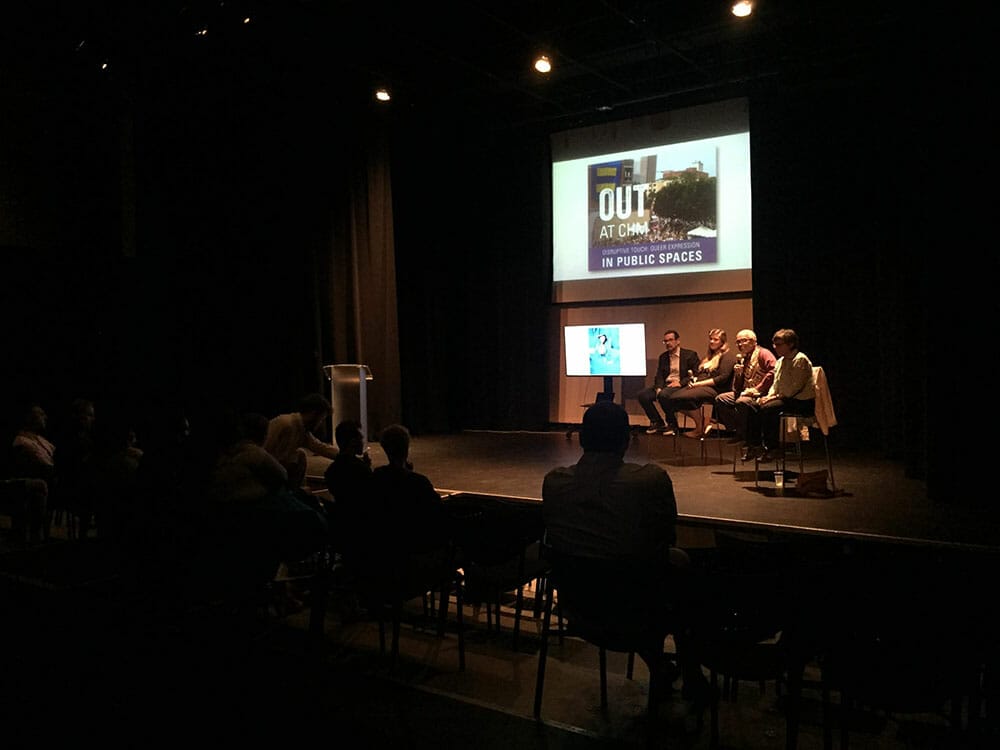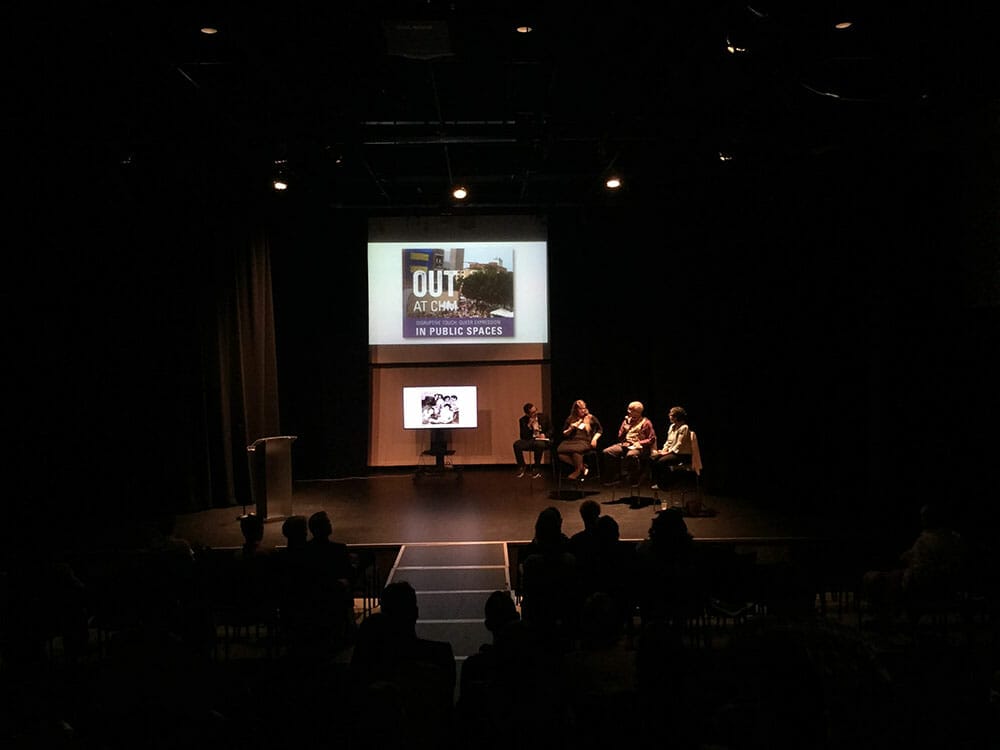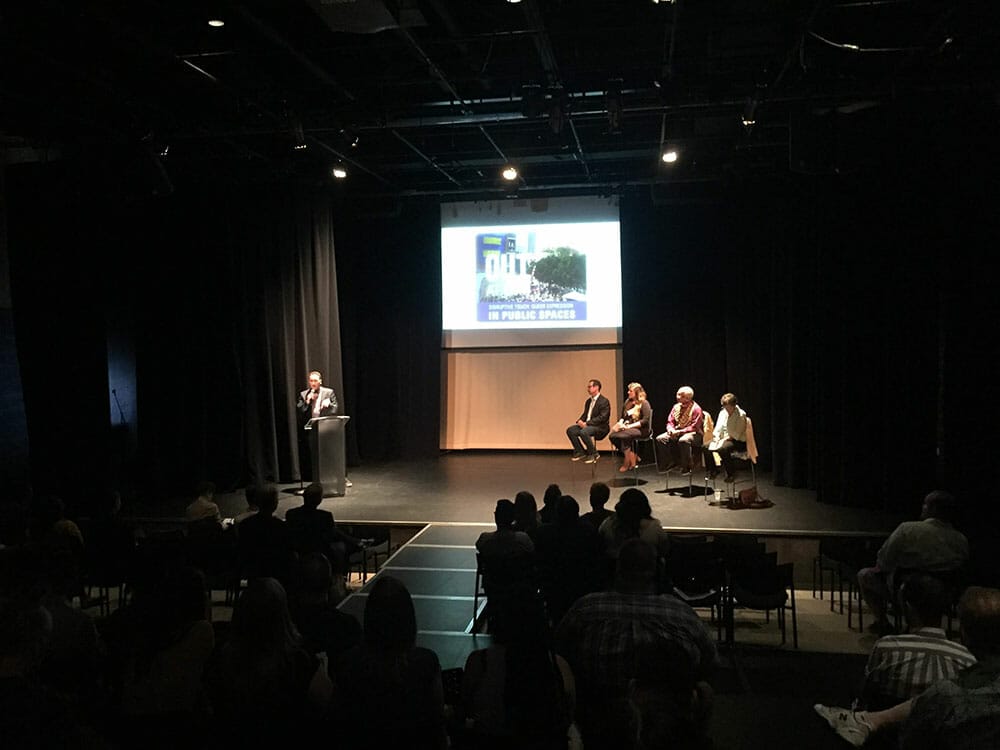Chicago History Museum at Center on Halsted First Impressions
The venue is surrounded by light posts covered in Pride flags, which is a stark contrast to the rest of the area surrounding the Addison Red Line Stop. Upon entering the beautifully modern space there’s a check-in table where greeters handout paper rainbow wristbands before giving them directions to the third floor for the main events. The second you step out of the elevator you’re hit with an indescribable sense of community. Sounds of laughter and conversation drown out the music as guests, audience, and organizers mingle near the tables of food and meander with local vendors set up at tables around the space.
Strangers make a point to say hello to everyone and introduce themselves while relaying their stories and how long they’ve been coming to these events. The common theme from all of the conversations seems to be that these events serve a purpose and have been taking place for fifteen years. While the event was held at the Center on Halsted, the origins of the event began with the Chicago History Museum that hosted the event. The museum held an event on LGBT fashion about fifteen years ago and then “Wanted to keep momentum going about LGBT life. This committee has been going since,” David Deyhle, Vice President of the Chicago History Museum, explains. “We host three events a year- January, March, and May or June. We always approach with some sort of historic angle because we are a history museum.” Deyhle, went on to say, “It’s been exciting, as a museum, we’ve been with the committee for all of these changes over the last decade in a half.”
“The Chicago History Museum, and Out at Chicago History, is a marquee program for the city of Chicago to share these vital stories of Chicago and our region, “ says the Chair of CHM, Yusef Garcia. “Specifically, CHM works to tell the stories of the diverse LGBT community in our region.”
Brief History of the LQBTQ+ Community in Chicago
The event shifted from mingling to a panel featuring Michelle Citron, Patric McCoy, Andie Meadows and moderator Owen Keehnen. While the panel was assembled with a focus on public displays of affection and the ramifications for couples who are not hetero-sexual, each panelist approached the issue with a specialized viewpoint from their place within the LGBTQ+ community. Andie discussed what it was like moving from rural Maryland to Boystown as an underage young woman and the lack of representation for non-CIS white men within Boystown. Patric showed photos of his time as a young photographer documenting Queer Black Culture from 1980-1990 as he watched The Loop morph into an entirely different place. Michelle primarily focused on the two women in the documentary she would screen to close out the night – after they passed away in their 80’s it was revealed that they had loads of pictures going back as far as the 1930’s documenting white working-class lesbians in Chicago. Meanwhile, Owen educated us on The Belmont Rocks and what its disappearance meant for Queer Culture in Chicago.
All panelists’ accounts, stories, and photos, served to give a brief history of Queer Culture in Chicago that-in this reporter’s opinion- was insightful, touching, and at times quite humorous. When the floor was opened for questions the conversation turned to topics such as: How will social media affect the documentation of this generation’s young queer culture? Does the current climate make queer expression less taboo than in previous decades? Where is the history of non-binary and trans-people in this historical documentation? This last question led to a discussion about the lack of documentation possibly being due to lack of visibility to which one woman raised her hand and said, “Everyday trans-people are committing to visibility. Every time we walk out of our doors-I’m a six foot four trans-woman. I’m doing my part and can’t help it.”
After the discussion ended there was a short break for people to go back to mingling and shopping with local vendors before attention shifted to Citron’s documentary Lives Visible. While the documentary focused on two women and their white working class lesbian group of friends, the letters and poems written by the couple were read by queer women of different ethnicities. The documentary also mentioned some of the ways “butch femmes” would get around the bigotry and police raids of lesbian bars in order to live their authentic dress in gender non-conforming ways.
The evening was filled with a ton of information but only touched upon a bit of the history of Chicago’s Queer Scene.
For more information on the panelists with online presences: Michelle Citron can be found on Instagram at @livesvisible, Andie Meadows Instagram handle is @_miss_meadows, and Owen Keehnen’s Twitter account is @OwenKeehnen.
Go to Chicago History Museum’s website for more information.
Photos courtesy of Chicago History Museum
About the Author
Sharai Bohannon is a playwright, and an avid theatre practitioner, who is very excited to write about most things but especially Chicago Theatre. She has a background in journalism and technical theatre and is excited that those degrees will be put to use in a way that gives her an excuse to leave her couch and brave this “outside” that people keep telling her about. When not on her couch watching TV, she can be found working one of her multiple jobs and/or hunting down a happy hour near you. Read some of Sharai Bohannon’s New Works on New Play Exchange.
Read more Picture this Post reviews by Sharai Bohannon here.






